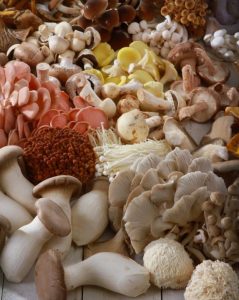Before I ever sipped coffee or knew how to scramble an egg, my first “drink” word was tea.
It’s no surprise—my mom and dad have always been tea drinkers.
 Even now, my mom keeps her pantry stocked with a special teecino blend just for me, and I always have a stash of herbal teas at home for those moments when someone’s under the weather or just needs a little comfort.
Even now, my mom keeps her pantry stocked with a special teecino blend just for me, and I always have a stash of herbal teas at home for those moments when someone’s under the weather or just needs a little comfort.
As we look ahead to Mother’s Day brunch, I’ve been reflecting on the simple, nourishing ways we can honor the women who care for us so deeply—starting with a beautiful meal made from fresh, local ingredients.
My mom lives just across the road from us on the farm and continues to be such a strong and quiet part of our everyday life. Even as her health has slowed her down, she welcomes our littlest kids into her cozy home, keeps her real-food pantry well stocked, and still nurtures her love of gardening—something she now shares with our daughter Annika, the flower farmer.
Moms pour so much into others—often quietly, steadily, and with deep love.
That’s why I believe the most meaningful way to celebrate them is with something simple, thoughtful, and nourishing.
A beautiful brunch made with fresh, local ingredients is more than just a meal—it’s a way to say thank you with every bite.
Whether you’re cooking for your mom, sharing the kitchen with your kids, or honoring a mother-figure in your life, these ideas are meant to help you create something special with what you have—whether it’s in your Market Box or picked up at the General Store.
From savory mains to sweet treats and herbal sips, here’s how to build a Mother’s Day brunch that’s fresh, local, and full of love.
FEATURED: Mother’s Day Brunch Ideas with In Season Ingredients
Celebrate the special women in our lives with a brunch that highlights fresh, local produce and vibrant flavors.
We’ve compiled some simple ideas for you filled with seasonal flavor.
These recipes are designed to be flexible and easy to scale, whether feeding a crowd or preparing a more intimate spread.
Use these ideas to create a nourishing, creative, and delicious menu!
MEAL IDEAS FOR YOUR LOCAL ORGANIC FOOD THIS WEEK:
Many of these recipes include produce or other items you may have received in your market box. You may also see ingredients you can purchase at the WHF General Store. Experiment and see what you can use to create your meal plan!
💡Pro tip: Always check your recipes to see what you have and what you need to purchase. Takes a few extra minutes in planning, but it beats finding out at the last minute that you’re missing ingredients!
🌿 Savory Mains
- Spring Greens Frittata – Use any tender greens: baby kale, spinach, arugula, parsley, dandelion greens, or blanched nettle. Add green onions and caramelized onion for flavor. Optional mix-ins: roasted potatoes, cheese, smoked salmon, or bacon.
- 💡Tip: Use this frittata formula for great results. Keep it on hand to use again.
- Sweet Potato & Beet Rösti – Grated sweet potatoes and beets formed into patties and pan-fried until crispy. Serve topped with eggs, smoked fish, or dressed greens.
- 💡Tip: Start with this basic potato rosti recipe and customize with beetroot. Or try this beetroot, potato, and horseradish rosti.
- Grilled Citrus Chicken or Shrimp Skewers – Marinate in citrus juice, olive oil, garlic, and herbs. Skewer with onion or sweet potato chunks and grill or roast. Simple to scale.
- Seared Scallops or Cod with Wilted Greens – Serve quick-seared scallops or cod over a bed of sautéed spinach, Swiss chard, or dandelion greens. Finish with a citrusy pan sauce.
- 💡Tip: Use the lemon pan sauce in this recipe and add or substitute orange juice.
🥗 Fresh & Vibrant Sides
- Shaved Cabbage, Apple & Radish Slaw – Combine cabbage, apples, watermelon radish, and parsley. Dress with citrus juice, honey, olive oil, and salt. Add chopped dandelion greens for a bitter note.
- 💡Tip: You can refer to our Spring Salad Dressings post for dressing help and specifics.
- Warm Potato & Dandelion Salad – Roast yellow potatoes and toss with lightly wilted dandelion greens and mustard vinaigrette. Optional: top with eggs, chicken, or salmon.
- Spring Tartines – Top toasted sourdough bread with a creamy spread (herbed fromage blanc, whipped ricotta, or dandelion pesto), and layer with smoked salmon, radishes, or greens.
🍰 Sweet Treats
- Carrot Citrus Mini Cakes – Grated carrots, citrus zest, olive oil, and a hint of spice. Bake into muffins or mini loaves. Serve with honey-sweetened yogurt or whipped cream.
- Beet-Chocolate Muffins – A moist, earthy-sweet treat. Optional add-ins: nuts, seeds, herbs, or a citrus glaze.
- 💡Tip: Herbs like thyme, mint, or lavender would work well with the flavors in this muffin. Use just a bit – 1-2 tsp. fresh or 1 tsp. dried.
🥂 Seasonal Sips
- Elderflower Citrus Spritzer – Mix citrus juice with elderflower soda or sparkling water. Add herbs or edible flowers. Optional: spike with gin or sparkling wine.
- Herb-Infused Iced Tea – Brew chamomile or green tea with parsley stems or mint. Chill and serve with citrus slices.
FEATURED: Tea and Honey
Nothing goes with tea like sweet local honey.
Want some new ways to use tea and honey in your kitchen?
Our Seasonal Pairing Guide highlights tea and honey combinations for each season, featuring ideas for drinks, savory dishes, and sweet treats. Whether crafting a refreshing iced tea or glazing roasted veggies, this guide will inspire your culinary creations all year long. Check it out and discover seasonal flavor combos to make life a little sweeter. 🐝
BREAD:
- Invite our sourdough bread to your Mother’s Day Brunch! Pick up a loaf or two for making the tartines above, then use the rest for sandwiches or toast later in the week.
- Our brioche makes amazing French toast!
MEAT AND SEAFOOD:
- Add smoked salmon to your frittata recipe or use it to top your potato and beet rösti.
- Bacon. It’s brunch. You need bacon! Add crumbled bacon to your frittata or serve as a side.
- Salmon, cod, and scallops from Wild for Salmon are great brunch choices.
DAIRY:
- Make sure you have plenty of eggs for your frittata recipe.
- We have a variety of raw milk and artisan cheeses to add to your frittata or use for an appetizer charcuterie board.
- Top your tartines with fresh cheese from our online store. Fromage blanc or chèvre would be excellent choices.
PANTRY RECOMMENDATIONS:
- We have all your baking needs in our online store: flours, sugars, honey, cocoa powder, chocolate chips, and more!
- Add coffee, tea, or Dandy Blend to your market box order.
- Visit our beverage section for sodas, sparkling waters, and juices to make delicious seasonal cocktails/mocktails to accompany your meals.
💐 Stop in and visit us at WHF General Store for your Mother’s Day meal needs. We also have cards, flowers, treats, and unique locally-made gifts!
FRUIT:
Storage for all apple varieties:
Keep unwashed apples in a plastic bag in the refrigerator’s crisper drawer, where they can stay fresh for up to two weeks.
 Apple, Crimson Topaz – Crimson Topaz is a striking red apple with a tangy-sweet flavor, originally bred in the Czech Republic and now grown in small quantities elsewhere. It’s an organic grower’s favorite thanks to its natural disease resistance. Nutritionally, it’s similar to other apples – low in calories, high in fiber, and rich in vitamin C and antioxidants from its deep red skin. Crimson Topaz apples are great for fresh eating if you like a sharper bite, and they add depth to salads and cheese boards. They also bake beautifully, adding tartness to pastries and tarts.
Apple, Crimson Topaz – Crimson Topaz is a striking red apple with a tangy-sweet flavor, originally bred in the Czech Republic and now grown in small quantities elsewhere. It’s an organic grower’s favorite thanks to its natural disease resistance. Nutritionally, it’s similar to other apples – low in calories, high in fiber, and rich in vitamin C and antioxidants from its deep red skin. Crimson Topaz apples are great for fresh eating if you like a sharper bite, and they add depth to salads and cheese boards. They also bake beautifully, adding tartness to pastries and tarts.
 Apple, EverCrisp – EverCrisp apples are a hybrid of Honeycrisp and Fuji, combining the crisp texture of the former with the sweetness and dense flesh of the latter. Developed for late-season storage, they retain their crunch and flavor for months when kept cold. Nutritionally, EverCrisp apples offer about 80–100 calories per medium apple, with around 4 grams of fiber and a good dose of vitamin C. They’re excellent for snacking due to their satisfying crunch and balanced sweetness, but also hold up well in pies, crisps, and slaws.
Apple, EverCrisp – EverCrisp apples are a hybrid of Honeycrisp and Fuji, combining the crisp texture of the former with the sweetness and dense flesh of the latter. Developed for late-season storage, they retain their crunch and flavor for months when kept cold. Nutritionally, EverCrisp apples offer about 80–100 calories per medium apple, with around 4 grams of fiber and a good dose of vitamin C. They’re excellent for snacking due to their satisfying crunch and balanced sweetness, but also hold up well in pies, crisps, and slaws.
 Apple, Fuji – Fuji apples are sweet, crisp, and juicy, with a dense texture, making them a popular snacking apple. They are rich in dietary fiber, vitamin C, and antioxidants, which support digestion, immune health, and skin vitality. Fuji apples can be eaten fresh, added to salads, baked into desserts, or cooked into sauces.
Apple, Fuji – Fuji apples are sweet, crisp, and juicy, with a dense texture, making them a popular snacking apple. They are rich in dietary fiber, vitamin C, and antioxidants, which support digestion, immune health, and skin vitality. Fuji apples can be eaten fresh, added to salads, baked into desserts, or cooked into sauces.
 Grapefruit – Grapefruit is a citrus fruit known for its juicy, tangy-sweet flavor with a slight bitterness. It is rich in vitamin C, fiber, and antioxidants like lycopene, promoting immune health, heart health, and skin health. Grapefruit can be eaten fresh, added to salads, or juiced for a refreshing drink. Store whole grapefruit at room temperature for up to a week or in the refrigerator for up to three weeks.
Grapefruit – Grapefruit is a citrus fruit known for its juicy, tangy-sweet flavor with a slight bitterness. It is rich in vitamin C, fiber, and antioxidants like lycopene, promoting immune health, heart health, and skin health. Grapefruit can be eaten fresh, added to salads, or juiced for a refreshing drink. Store whole grapefruit at room temperature for up to a week or in the refrigerator for up to three weeks.

Lemon – Lemons are tangy citrus fruits packed with vitamin C, antioxidants, and citric acid, which aid digestion, boost immunity, and enhance skin health. They are commonly used to add flavor to beverages, marinades, dressings, and desserts or as a natural cleaning agent. Store lemons at room temperature if using them soon or refrigerate them in a perforated bag to extend their shelf life up to 3-4 weeks.
Orange, Mandarin – These small, sweet citrus fruits have a thin, easy-to-peel skin. They are high in vitamin C, fiber, and flavonoids, supporting immune function, digestion, and heart health. Mandarins are perfect for snacking, adding to desserts, or tossing into salads. Store them at room temperature for a few days or refrigerate to extend freshness for up to two weeks.
 Orange, Navel – Navel oranges are sweet, seedless, and easy to peel, making them an excellent snack or addition to salads and desserts. They are high in vitamin C, fiber, and antioxidants, which promote immune health and support heart health. Store navel oranges at room temperature for up to a week or refrigerate them in a mesh bag for up to three weeks to maintain freshness. Wash before peeling or slicing.
Orange, Navel – Navel oranges are sweet, seedless, and easy to peel, making them an excellent snack or addition to salads and desserts. They are high in vitamin C, fiber, and antioxidants, which promote immune health and support heart health. Store navel oranges at room temperature for up to a week or refrigerate them in a mesh bag for up to three weeks to maintain freshness. Wash before peeling or slicing.
Organic Veggies We Harvested This Week:
To help you use everything in your box this week, use this Meal Planning Guide to keep track of what’s in the fridge, what needs to be used first, and what you have planned or prepped for each day.
Every member’s customized Market Box is unique so we hope you will take advantage of more varieties of vegetables as you get comfortable with all the great organic produce we are offering.
Tessa’s Tips
What to use first: greens, mushrooms, green onions
Longest Storage: apples, beets, carrots, potatoes
Pro-tip: Look at the items in your market box right away and decide how you will use them in your meal planning for the week. Freeze any veggies you know you won’t be able to eat in the week.

Arugula – This leafy green has a peppery, slightly bitter flavor and is commonly used in salads, sandwiches, and as a garnish. It is low in calories and packed with vitamins A, C, and K, as well as folate and antioxidants, which support eye health, immune function, and bone strength. Arugula can be eaten fresh or lightly wilted in pasta dishes and pizzas. Some prefer to eat it tossed with other fresh greens or lettuce so that the spicy taste is not as strong. Putting it on a sandwich is another delicious way to enjoy its distinct flavor. Store wrapped in a paper towel inside a loosely sealed plastic bag in the refrigerator crisper drawer. Properly stored, arugula can stay fresh for up to 3-5 days. For best quality, use arugula soon after purchasing.
Arugula isn’t just for salad. Here are 29 Ways to Eat Arugula including pasta dishes, pizza, sandwiches, and more.
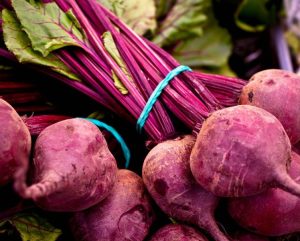 Beet, Red – Red beets are root vegetables known for their earthy flavor and vibrant red-purple color. They are rich in nutrients like folate, manganese, potassium, dietary fiber, and antioxidants such as betalains, which help reduce inflammation and support heart health. Both the roots and greens are edible, with the greens offering additional nutrients like vitamins A and C. Beets can be eaten raw in salads, roasted, boiled, or blended into smoothies and soups. Store beet greens separately from the root, wrapped in a damp cloth or in a plastic bag in the fridge. Use within a few days – they don’t keep long. Beetroots can be stored in a plastic bag in the fridge’s crisper drawer for up to two weeks. To freeze beets for longer storage, slice or chop them, spread on a cookie sheet to flash freeze, then transfer to freezer bags where they can be stored for up to a year.
Beet, Red – Red beets are root vegetables known for their earthy flavor and vibrant red-purple color. They are rich in nutrients like folate, manganese, potassium, dietary fiber, and antioxidants such as betalains, which help reduce inflammation and support heart health. Both the roots and greens are edible, with the greens offering additional nutrients like vitamins A and C. Beets can be eaten raw in salads, roasted, boiled, or blended into smoothies and soups. Store beet greens separately from the root, wrapped in a damp cloth or in a plastic bag in the fridge. Use within a few days – they don’t keep long. Beetroots can be stored in a plastic bag in the fridge’s crisper drawer for up to two weeks. To freeze beets for longer storage, slice or chop them, spread on a cookie sheet to flash freeze, then transfer to freezer bags where they can be stored for up to a year.
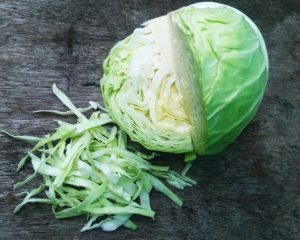 Cabbage, Green – Green cabbage is a nutrient-dense cruciferous vegetable in the Brassica family, known for its tightly packed, round, pale green leaves. It is rich in vitamins C and K, as well as fiber and antioxidants, which are beneficial for immune health, digestion, and bone strength. With a mild, slightly peppery taste, green cabbage can be enjoyed raw in salads and slaws, or cooked in stir-fries, soups, and stews. To store, keep green cabbage unwashed in a perforated plastic bag in the refrigerator’s crisper drawer, where it can stay fresh for up to two weeks.
Cabbage, Green – Green cabbage is a nutrient-dense cruciferous vegetable in the Brassica family, known for its tightly packed, round, pale green leaves. It is rich in vitamins C and K, as well as fiber and antioxidants, which are beneficial for immune health, digestion, and bone strength. With a mild, slightly peppery taste, green cabbage can be enjoyed raw in salads and slaws, or cooked in stir-fries, soups, and stews. To store, keep green cabbage unwashed in a perforated plastic bag in the refrigerator’s crisper drawer, where it can stay fresh for up to two weeks.
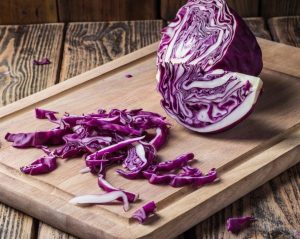 Cabbage, Red – Red cabbage is a vibrant vegetable with a slightly peppery and sweet flavor. It is rich in vitamins C and K, fiber, and antioxidants like anthocyanins, which support immune health, digestion, and reduce inflammation. Red cabbage can be eaten raw in salads and slaws, pickled, or cooked in stir-fries, soups, and stews. Store it in the refrigerator, unwashed, in a plastic bag, where it can stay fresh for up to two weeks.
Cabbage, Red – Red cabbage is a vibrant vegetable with a slightly peppery and sweet flavor. It is rich in vitamins C and K, fiber, and antioxidants like anthocyanins, which support immune health, digestion, and reduce inflammation. Red cabbage can be eaten raw in salads and slaws, pickled, or cooked in stir-fries, soups, and stews. Store it in the refrigerator, unwashed, in a plastic bag, where it can stay fresh for up to two weeks.
Try using red cabbage to make quick pickled cabbage. Thinly slice the cabbage, then toss it with vinegar, lime juice, a pinch of sugar, and spices like cumin or chili flakes. Let it sit for 30 minutes to develop flavor. The result is a tangy, crunchy topping that adds both texture and a pop of color to your meal. Perfect for tacos, burgers, or grain bowls!
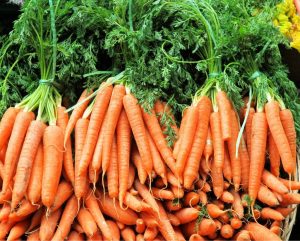 Carrot – Carrots are a versatile and popular root vegetable, known for their sweet, crunchy texture and vibrant orange color, though they can also be found in purple, yellow, and red varieties. They are rich in beta-carotene, which the body converts to vitamin A, essential for good vision and immune health. Carrots are a good source of dietary fiber, potassium, and antioxidants. Enjoy them raw, cooked, roasted, or juiced. They can be used in salads, soups, stews, and side dishes. For optimal storage, store carrots unwashed in the fridge, preferably in a plastic bag or container to maintain moisture, where they can last for several weeks. If the greens are attached, cut them off to prevent the carrots from becoming limp. Stored properly, they should last around 1-2 weeks.
Carrot – Carrots are a versatile and popular root vegetable, known for their sweet, crunchy texture and vibrant orange color, though they can also be found in purple, yellow, and red varieties. They are rich in beta-carotene, which the body converts to vitamin A, essential for good vision and immune health. Carrots are a good source of dietary fiber, potassium, and antioxidants. Enjoy them raw, cooked, roasted, or juiced. They can be used in salads, soups, stews, and side dishes. For optimal storage, store carrots unwashed in the fridge, preferably in a plastic bag or container to maintain moisture, where they can last for several weeks. If the greens are attached, cut them off to prevent the carrots from becoming limp. Stored properly, they should last around 1-2 weeks.

Carrot, Rainbow – In addition to the nutritional benefits above, rainbow carrots stand out from standard orange carrots with their vibrant colors—purple, yellow, red, and white—each offering unique nutritional benefits and distinct flavors. Purple carrots contain anthocyanins, powerful antioxidants linked to anti-inflammatory and heart-health benefits, with a slightly earthy, spicy taste. Yellow carrots are rich in lutein, which promotes eye health by protecting against macular degeneration and cataracts, and they have a mild, subtly sweet flavor. Red carrots contain lycopene, a potent antioxidant that supports heart health, reduces the risk of certain cancers, and helps protect skin from UV damage, with a richer, sweeter taste.
These colorful carrots are perfect for adding visual appeal to dishes and enhancing the taste profile, whether roasted to bring out their natural sweetness, or sliced raw for salads. Their distinct flavors can also add depth to juices and smoothies. The diverse hues, flavors, and nutrients of rainbow carrots make them perfect for garnishes or serving as part of a vegetable medley. Store rainbow carrots the same way you would store standard orange carrots.
 Celery – Celery is a crunchy, low-calorie vegetable known for its mild, slightly salty flavor. It is rich in vitamins K and C, folate, potassium, and fiber, supporting bone health, digestion, and hydration. Celery is often eaten raw as a snack, added to salads, or used as a base in soups, stews, and stir-fries. Store celery in the refrigerator, tightly wrapped in aluminum foil to retain its crispness, where it can stay fresh for up to two weeks. For longer storage, celery can be chopped and frozen.
Celery – Celery is a crunchy, low-calorie vegetable known for its mild, slightly salty flavor. It is rich in vitamins K and C, folate, potassium, and fiber, supporting bone health, digestion, and hydration. Celery is often eaten raw as a snack, added to salads, or used as a base in soups, stews, and stir-fries. Store celery in the refrigerator, tightly wrapped in aluminum foil to retain its crispness, where it can stay fresh for up to two weeks. For longer storage, celery can be chopped and frozen.
Don’t forget to use those celery greens! They’re a great addition to cooked beans, salads, eggs. Use leaves to make pesto or dry them and make your own parsley flakes, powder, or salt.
 Ginger – Ginger is a flavorful root widely used as a spice and natural remedy. It has a warm, slightly spicy taste and is rich in bioactive compounds like gingerol, which has anti-inflammatory and antioxidant properties. Ginger aids digestion, relieves nausea, and supports immune health. It is versatile in cooking and used in teas, curries, stir-fries, baked goods, and beverages. Store fresh ginger in a cool, dry place for short-term use or in the refrigerator in a paper towel or airtight bag for extended freshness. For long-term storage, freeze peeled or sliced ginger.
Ginger – Ginger is a flavorful root widely used as a spice and natural remedy. It has a warm, slightly spicy taste and is rich in bioactive compounds like gingerol, which has anti-inflammatory and antioxidant properties. Ginger aids digestion, relieves nausea, and supports immune health. It is versatile in cooking and used in teas, curries, stir-fries, baked goods, and beverages. Store fresh ginger in a cool, dry place for short-term use or in the refrigerator in a paper towel or airtight bag for extended freshness. For long-term storage, freeze peeled or sliced ginger.
Freeze your fresh ginger for longer storage: Peel and slice or grate the ginger. Freeze in an airtight container or ice cube tray. You can also freeze the whole unpeeled root in a freezer bag. Grate or slice directly from frozen as needed.
 Green Onions – Green onions, also known as scallions, have a mild, slightly sweet onion flavor and are packed with vitamins A and K. They are often used raw in salads, salsas, and garnishes but also add depth to stir-fries, soups, and omelets. Their green tops and white bulbs are both edible, making them a versatile ingredient. Store in the refrigerator, wrapped in a damp paper towel inside a bag, or stand them in a jar of water to keep them fresh longer.
Green Onions – Green onions, also known as scallions, have a mild, slightly sweet onion flavor and are packed with vitamins A and K. They are often used raw in salads, salsas, and garnishes but also add depth to stir-fries, soups, and omelets. Their green tops and white bulbs are both edible, making them a versatile ingredient. Store in the refrigerator, wrapped in a damp paper towel inside a bag, or stand them in a jar of water to keep them fresh longer.
 Kale (baby) – Compared to mature kale, baby kale has a milder flavor and more tender leaves, making it ideal for raw applications like salads or smoothies. Nutritionally, it retains the same benefits—rich in vitamins A, C, and K—but may have slightly lower fiber content due to its delicate structure. Store it in a sealed container with a dry paper towel in the fridge and use within a few days to prevent wilting.
Kale (baby) – Compared to mature kale, baby kale has a milder flavor and more tender leaves, making it ideal for raw applications like salads or smoothies. Nutritionally, it retains the same benefits—rich in vitamins A, C, and K—but may have slightly lower fiber content due to its delicate structure. Store it in a sealed container with a dry paper towel in the fridge and use within a few days to prevent wilting.
Mushroom Varieties
Store mushrooms in a paper bag or breathable container in the refrigerator, avoiding moisture buildup, and only wash them right before use to maintain freshness.
Mushrooms are super versatile in the kitchen. Here are 10 Things You Should Do With Mushrooms.
This roundup of 20 Mushroom Recipes has you covered with meal ideas for breakfast, lunch, or dinner.
Mushroom, Portobello & Cremini – Portobello mushrooms are mature versions of cremini mushrooms, offering a meaty texture and rich, earthy flavor. Cremini, also known as “baby bellas,” are younger, smaller, and have a firmer texture with a milder taste. Both are low in calories, fat-free, cholesterol-free, and provide B vitamins, selenium, potassium, and antioxidants. Portobellos are ideal for grilling, roasting, or as a meat substitute in burgers, sandwiches, or stuffed recipes. Creminis are great for sautéing, adding to soups, stir-fries, pasta dishes, or as pizza and salad toppings.
Mushroom, Lion’s Mane – Lion’s mane mushrooms are known for their shaggy, white appearance and mild, slightly sweet, seafood-like flavor. Rich in antioxidants, they contain compounds that may support brain health, nerve regeneration, and immune function. These mushrooms can be sautéed, roasted, or added to soups and stir-fries, often used as a meat substitute due to their tender, meaty texture. Store them in a paper bag in the fridge and use within a few days for the best texture and flavor.
Mushroom, Shiitake – Shiitake mushrooms are prized for their rich, umami flavor and slightly chewy texture, making them a staple in Asian cuisine. They are low in calories, fat-free, and a good source of B vitamins, copper, selenium, and immune-supporting polysaccharides. Shiitakes are versatile and can be sautéed, stir-fried, grilled, or added to soups, stews, and sauces for a depth of flavor. They are popular in dishes like ramen, risotto, and dumplings, and are often used in vegetarian recipes for their meaty texture.
💡Tip: The artisan mushroom sampler is a great way to try different varieties of mushrooms. While we can’t predict or guarantee what will be included, the sampler often includes varieties such as enoki, oyster, shiitake, or trumpet mushrooms!
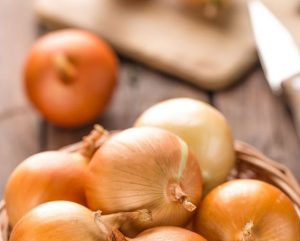
Onion, Yellow – Yellow onions are a popular, versatile vegetable with golden-brown skin and a strong, savory flavor that mellows and sweetens when cooked. Rich in antioxidants, vitamin C, and fiber, yellow onions support immune health, digestion, and overall cellular health. They’re a staple in many cuisines, perfect for sautéing, caramelizing, roasting, and adding depth to soups, stews, and sauces. To store, keep unpeeled yellow onions in a cool, dry, well-ventilated place, away from potatoes, where they can last up to a month; once peeled or cut, store them in an airtight container in the refrigerator for up to a week.
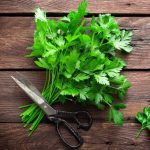 Parsley, Flat Italian – Parsley is a popular herb with bright green leaves and a fresh, slightly peppery flavor. It is rich in vitamins A, C, and K, along with folate and antioxidants, which support immune health, bone health, and digestion. Parsley is used as both a garnish and a key ingredient in various dishes. It is commonly used in Mediterranean and Middle Eastern cuisines, adding flavor to salads, soups, sauces, and marinades. Store in a glass with some water on the counter as you would any herb. Keep for several days. For longer storage, parsley can be chopped and frozen in airtight containers or ice cube trays.
Parsley, Flat Italian – Parsley is a popular herb with bright green leaves and a fresh, slightly peppery flavor. It is rich in vitamins A, C, and K, along with folate and antioxidants, which support immune health, bone health, and digestion. Parsley is used as both a garnish and a key ingredient in various dishes. It is commonly used in Mediterranean and Middle Eastern cuisines, adding flavor to salads, soups, sauces, and marinades. Store in a glass with some water on the counter as you would any herb. Keep for several days. For longer storage, parsley can be chopped and frozen in airtight containers or ice cube trays.
 Potato, Yellow – Also known as Yukon Gold or gold potatoes, yellow potatoes have smooth, thin, yellowish skin and creamy, buttery-flavored flesh. They are slightly waxy, making them versatile in cooking. Yellow potatoes are a good source of vitamin C, potassium, and fiber and are low in calories and fat. Their creamy texture makes them ideal for mashing, roasting, grilling, and boiling. They are also excellent in gratins and salads because they hold shape during cooking. Store yellow potatoes in a cool, dark, and well-ventilated place for several weeks, avoiding refrigeration as it can alter their texture and flavor.
Potato, Yellow – Also known as Yukon Gold or gold potatoes, yellow potatoes have smooth, thin, yellowish skin and creamy, buttery-flavored flesh. They are slightly waxy, making them versatile in cooking. Yellow potatoes are a good source of vitamin C, potassium, and fiber and are low in calories and fat. Their creamy texture makes them ideal for mashing, roasting, grilling, and boiling. They are also excellent in gratins and salads because they hold shape during cooking. Store yellow potatoes in a cool, dark, and well-ventilated place for several weeks, avoiding refrigeration as it can alter their texture and flavor.
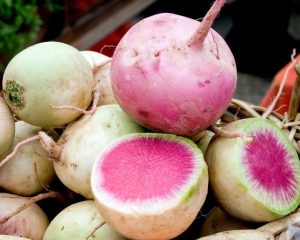 Radish, Watermelon – Watermelon radish is a striking root vegetable with a mild, slightly sweet flavor and a crisp texture. Its pale green skin hides a vibrant pink interior, resembling a watermelon. Rich in vitamin C, potassium, and antioxidants, it supports immune health and reduces inflammation. Watermelon radishes can be enjoyed raw in salads, sliced thinly for garnishes, pickled, or roasted for a milder flavor. Store unwashed watermelon radishes in a perforated plastic bag in the refrigerator, where they can stay fresh for up to two weeks. Wash and trim just before using.
Radish, Watermelon – Watermelon radish is a striking root vegetable with a mild, slightly sweet flavor and a crisp texture. Its pale green skin hides a vibrant pink interior, resembling a watermelon. Rich in vitamin C, potassium, and antioxidants, it supports immune health and reduces inflammation. Watermelon radishes can be enjoyed raw in salads, sliced thinly for garnishes, pickled, or roasted for a milder flavor. Store unwashed watermelon radishes in a perforated plastic bag in the refrigerator, where they can stay fresh for up to two weeks. Wash and trim just before using.
💡Tip: Watermelon radishes make beautiful and delicious chips!
Try this easy recipe: Toss thin slices with a little oil and salt, spread on a parchment-lined sheet, and roast at 400°F for 15-20 minutes, flipping halfway through. They’re finished when the edges begin to curl and the radishes turn lightly brown and crispy. Keep an eye on them – they go from perfect to too dark very quickly.
Seasoning Ideas:
- Mix olive oil with za’atar and a pinch of extra salt before roasting.
- Sprinkle with smoked paprika, garlic powder, and lemon zest post-roast.
- Toss with chili powder, cumin, and lime juice (add zest too for extra punch).
Pair finished chips with herbed goat cheese or yogurt, guacamole, or hummus.
 Rutabaga – Rutabaga is a round, root vegetable with yellowish flesh and a mildly sweet, earthy flavor. It is packed with fiber, vitamin C, and potassium, supporting digestion, immune health, and heart function. Rutabaga is excellent roasted, mashed, added to soups, or used in stews. Rutabaga can be thinly sliced and baked into crispy chips or grated and mixed into coleslaw for a unique twist. Its slightly sweet flavor also works wonderfully in casseroles or mixed with mashed potatoes for added depth. Store rutabaga in a cool, dark place or in the refrigerator, where it can stay fresh for several weeks.
Rutabaga – Rutabaga is a round, root vegetable with yellowish flesh and a mildly sweet, earthy flavor. It is packed with fiber, vitamin C, and potassium, supporting digestion, immune health, and heart function. Rutabaga is excellent roasted, mashed, added to soups, or used in stews. Rutabaga can be thinly sliced and baked into crispy chips or grated and mixed into coleslaw for a unique twist. Its slightly sweet flavor also works wonderfully in casseroles or mixed with mashed potatoes for added depth. Store rutabaga in a cool, dark place or in the refrigerator, where it can stay fresh for several weeks.
Fun Facts: Rutabagas are a cross between a turnip and a cabbage, giving them their unique flavor. Rutabaga is also known as swede which is short for “Swedish turnip.”
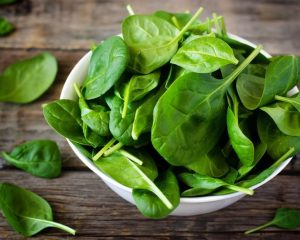 Spinach – Spinach is a nutrient-rich leafy green vegetable packed with vitamins A, C, K, and folate, along with minerals like iron and magnesium. Low in calories and high in antioxidants, it supports eye health, bone strength, and immune function. Spinach is versatile and can be enjoyed raw in salads, blended into smoothies, or cooked in soups, pasta, and omelets. To store, keep it dry in a perforated plastic bag in the fridge’s crisper drawer, and wash only before use. Properly stored, it stays fresh for 5-7 days.
Spinach – Spinach is a nutrient-rich leafy green vegetable packed with vitamins A, C, K, and folate, along with minerals like iron and magnesium. Low in calories and high in antioxidants, it supports eye health, bone strength, and immune function. Spinach is versatile and can be enjoyed raw in salads, blended into smoothies, or cooked in soups, pasta, and omelets. To store, keep it dry in a perforated plastic bag in the fridge’s crisper drawer, and wash only before use. Properly stored, it stays fresh for 5-7 days.
 Stinging Nettle – This wild, nutrient-rich leafy green is known for its fine, hair-like spines that sting when touched raw, though cooking, drying, or blending neutralizes the sting entirely. It has a mild, earthy flavor similar to spinach and has long been used in both culinary and herbal traditions. Nettles are packed with vitamins A, C, K, and B-complex, as well as iron, calcium, magnesium, potassium, and plant-based protein. They’re popular in soups, pestos, egg dishes, sautéed greens, and teas. Always blanch before eating to remove the sting. Store fresh nettles in the fridge wrapped in a damp paper towel inside a produce bag. Use within a few days, or blanch and either freeze or dry for long-term use. 💡Tip: Always handle raw nettles with gloves or tongs.
Stinging Nettle – This wild, nutrient-rich leafy green is known for its fine, hair-like spines that sting when touched raw, though cooking, drying, or blending neutralizes the sting entirely. It has a mild, earthy flavor similar to spinach and has long been used in both culinary and herbal traditions. Nettles are packed with vitamins A, C, K, and B-complex, as well as iron, calcium, magnesium, potassium, and plant-based protein. They’re popular in soups, pestos, egg dishes, sautéed greens, and teas. Always blanch before eating to remove the sting. Store fresh nettles in the fridge wrapped in a damp paper towel inside a produce bag. Use within a few days, or blanch and either freeze or dry for long-term use. 💡Tip: Always handle raw nettles with gloves or tongs.
Fun Facts: Stinging nettles aren’t just good for you—they’re good for the planet, too. Nettles grow abundantly without fertilizer and can be harvested multiple times a season. They’re considered a low-impact wild green, especially when foraged responsibly. Plus, they’re a favorite host plant for butterflies like the Red Admiral and Small Tortoiseshell, making them a quiet hero in supporting local pollinators and biodiversity.
 Sweet Potato, Fingerling – Sweet potato fingerlings are small, slender sweet potatoes with thin, edible skin and a naturally sweet, creamy texture. They are rich in fiber, beta-carotene, and vitamin C, promoting digestive and immune health. Roast, sauté, or air-fry them whole for a crispy skin and tender interior, or slice them into fries or hash. Store in a cool, dry place away from light, but avoid refrigeration as it can affect their texture.
Sweet Potato, Fingerling – Sweet potato fingerlings are small, slender sweet potatoes with thin, edible skin and a naturally sweet, creamy texture. They are rich in fiber, beta-carotene, and vitamin C, promoting digestive and immune health. Roast, sauté, or air-fry them whole for a crispy skin and tender interior, or slice them into fries or hash. Store in a cool, dry place away from light, but avoid refrigeration as it can affect their texture.
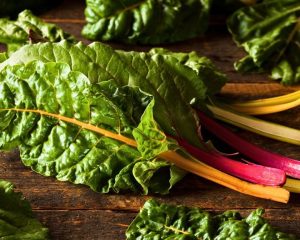 Swiss Chard – Swiss chard is a vibrant leafy green vegetable, rich in vitamins A, C, and K, as well as magnesium, potassium, and iron, making it a nutritious, low-calorie option. The stems come in various colors or simply a whitish green. Both the leaves and the stalks are edible. When picked very young, chard can be part of a green salad. But full-grown chard like in your box today has a very strong flavor and tough stems when eaten raw. Its slightly bitter, earthy flavor pairs well with garlic, lemon, and olive oil, and it can be sautéed or steamed. After cooking for several minutes, it can also be added to rice and beans or omelets. Chard can be sliced or chopped and added to soups. The stems work well in soups, stews, or as a celery substitute. Use Chard any way you would prepare spinach, allowing for longer cooking time for the stems. To store, keep unwashed in a plastic bag or container in the refrigerator’s crisper drawer, using it within 3–5 days; if it wilts, revive it by soaking in cold water before use. Before using, wash well in cool water and separate the leaves from the stems.
Swiss Chard – Swiss chard is a vibrant leafy green vegetable, rich in vitamins A, C, and K, as well as magnesium, potassium, and iron, making it a nutritious, low-calorie option. The stems come in various colors or simply a whitish green. Both the leaves and the stalks are edible. When picked very young, chard can be part of a green salad. But full-grown chard like in your box today has a very strong flavor and tough stems when eaten raw. Its slightly bitter, earthy flavor pairs well with garlic, lemon, and olive oil, and it can be sautéed or steamed. After cooking for several minutes, it can also be added to rice and beans or omelets. Chard can be sliced or chopped and added to soups. The stems work well in soups, stews, or as a celery substitute. Use Chard any way you would prepare spinach, allowing for longer cooking time for the stems. To store, keep unwashed in a plastic bag or container in the refrigerator’s crisper drawer, using it within 3–5 days; if it wilts, revive it by soaking in cold water before use. Before using, wash well in cool water and separate the leaves from the stems.
Fun fact: Chard is in the chenopod family which includes beets, spinach, and quinoa.
Don’t Forget: Online shopping opens Friday at 1 PM! 🛒 Stock your kitchen with these clean, nourishing ingredients to fuel your family with nutrient-dense meals. Be sure to grab your favorite staples and try something new for vibrant health this winter.
Don’t wait to join…
Veggie E-Books
Download these collections of tips and recipes for each veggie. You’ll use these as a reference throughout the season.
Arugula E-Book
Beets E-Book
Cabbage E-Book
Carrots E-Book
Fresh Herbs E-Book
Kale E-Book
Mushrooms E-Book
Onions E-Book
Potatoes E-Book
Radish E-Book
Scallion/Green Onion E-Book
Spinach E-Book
Swiss Chard E-Book
~~~~~
We’ll keep farming for you!
Reuben and Tessa DeMaster
Willow Haven Farm

Read Next
Elevate every season with simple, nourishing pairings of tea and honey. Discover creative ways to sip, cook, and celebrate real ingredients—from springtime blooms to cozy winter brews.


